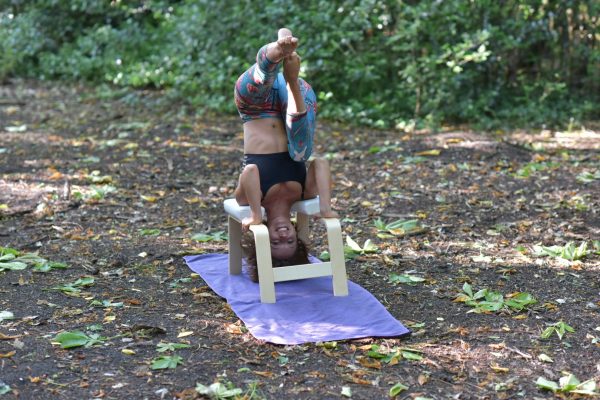If you have ever done one of my classes, you know I do not teach the famous yoga inversion “shoulder stand”.

There are 2 main reasons why I don’t teach this pose:
1- I don’t practice it myself
2- I don’t think it’s a safe pose to instruct in a mixed level group
When I work with more experienced students, I occasionally offer an inversion of their choice. Practitioners with a solid shoulders stand practice can go into it in a “self practice style”. And as the teacher I do not instruct the pose.
My experience with this pose
When I begun practicing shoulder stand, I felt great discomfort after. Sensations of sickness and nausea lasting for several hours would follow the practice.
I have a long and thin neck, which makes it particularly delicate and this probably explains why the pose doesn’t work for me.
Some teachers offered modifications of the pose, such as padding under the shoulders, but made little difference to how I felt after.
So I decided to leave it out and let it go.
I practice all other yoga inversions, such as headstand, forearm balance and handstand and none of these give me any discomfort.
Am I on my own on this? Apparently not.
According to the Yoga Journal I am not on my own: “The pose is said to flush out the lymph nodes, help regulate blood pressure and heart rate, strengthen the diaphragm, and stretch the chest muscles. Yet despite these benefits, many practitioners steer clear of Shoulderstand. The primary concern is that Shoulderstand puts too much pressure on the neck, or cervical spine, which can lead to injury”.
If you have been comfortably practicing this pose I am not saying you should stop doing it! But if you feel any discomfort in the area of your neck and shoulders after practicing this pose or feel dizzy or nauseated, then perhaps consider leaving it out.
How to safely invert?
Inversions require strength in the upper body and core, so that’s where I would recommend starting from. Build your strength through sun salutations, planks and other yoga poses to then be able to safely approach inversions.
One of my favourite teachers, Jason Crandell, suggests learning handstand before any other inversion. This may sound revolutionary and odd as it’s harder to balance in handstand, than it is in other inversions. But in handstand there is no compression on the cervical spine, so from a spine point of view, it is safer.
It does, though, require great strength and technique to be performed safely and it should be learnt under the supervision of an experienced teacher (like all other inversions).
Learning handstand first means that when it comes to other inversions where the head is resting on the floor, the beginner is familiar with the feeling of being inverted.
Meaning they are:
- ready to maintain the focus needed to safely stay upside down with pressure on the cervical spine
- strong enough to avoid collapsing all their body weight into the head
- more likely to actively press the floor away with their forearms, taking some of the weight away from the head
Another great way to get familiar with being upside down, minimizing the risk of injury is to use the Feet Up trainer. A padded stool with a hole for the head, which supports the shoulders. This prop allows you to invert with no pressure on head and neck. I have recently posted a video about it, check it out!
If you are new to yoga, don’t rush your inversions.
Get comfortable holding your plank and controlling the descent in modified chaturanga first. Gain strength in shoulders and core before you attempt inverting. If you decide to give shoulder stand a go, pay attention: notice how you feel during and after. If you experience discomfort, don’t do it – It’s not worth it!
Legs up the wall is a safer inversion and is a great alternative to shoulder stand. And it’s OK during your period too, ladies.
Inversions are fun and have plenty of benefits when done properly and when the body is ready. The key is to be patient and go one step at a time.

